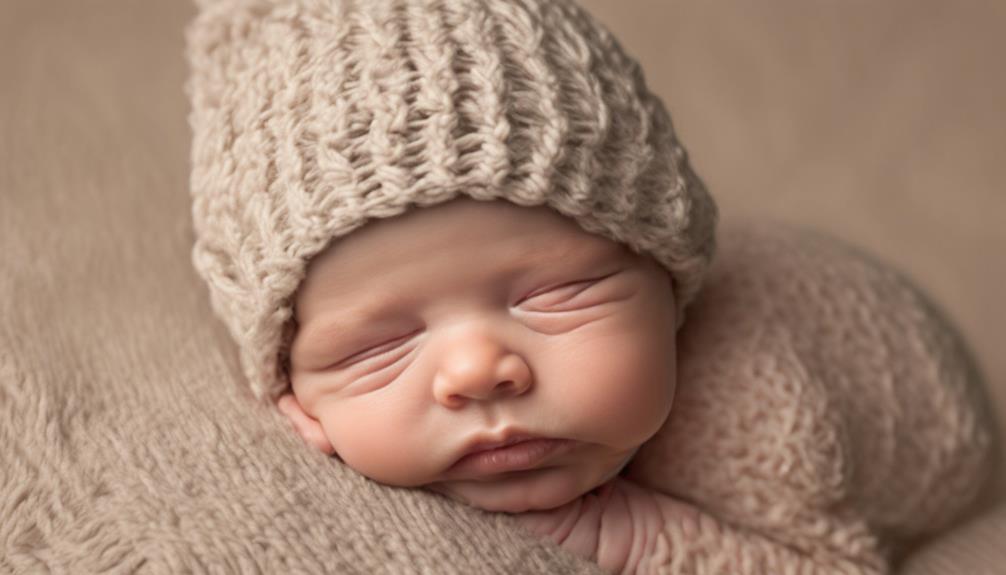As caregivers, we comprehend the challenges of soothing a restless newborn, especially when it comes to sleep. Did you know that studies show that approximately 25-30% of infants have trouble settling down for bedtime?
Finding effective solutions for your little one's nighttime restlessness can make a significant difference in both their well-being and your own. Let's explore some proven strategies and expert tips to help ease those fussy nights and promote better sleep for your baby.
Key Takeaways
- Establish consistent bedtime routines for sound sleep.
- Use gentle soothing techniques like swaddling and rocking.
- Create a relaxing sleep environment with safe sleep practices.
- Understand newborn sleep cycles and changes between sleep stages.
Establishing a Calming Bedtime Routine
Let's start creating a peaceful bedtime routine for your newborn to encourage better sleep patterns and a sense of security. Establishing a consistent bedtime routine is vital for helping your baby sleep soundly.
Engage in calming activities such as gentle rocking or singing a lullaby to create a soothing atmosphere before bedtime. These activities can signal to your newborn that it's time to wind down and prepare for sleep.
Avoid stimulating activities or screens close to bedtime, as they can interfere with your baby's ability to relax. By following a feed, play, sleep routine, you can help your newborn establish a pattern that aids in shifting to bedtime peacefully.
Consistency in bedtime routines is key to supporting your baby in developing positive sleep patterns and feeling secure before sleep. By incorporating these calming activities into your nightly routine, you can create a serene environment that promotes restful sleep for your little one.
Trying Gentle Soothing Techniques

To help your restless newborn settle down for better sleep, incorporating gentle soothing techniques like swaddling and rocking can be highly effective. Swaddling provides a comforting cocoon-like feeling for your baby, mimicking the secure environment of the womb and helping them feel safe and calm. The gentle pressure around their body can reduce startling movements, promoting longer and more restful sleep.
Rocking your baby in your arms or a rocking chair can also work wonders in soothing a fussy baby, as the rhythmic motion mimics what they experienced in utero. Additionally, using soft white noise or heartbeat sounds in the background can create a serene atmosphere that encourages your little one to drift off to sleep peacefully.
Consistency is key when implementing these techniques, as establishing a bedtime routine centered around gentle soothing practices can signal to your baby that it's time to rest, ultimately improving their sleep patterns and overall well-being.
Creating a Relaxing Sleep Environment

Creating a relaxing sleep environment for your newborn is crucial for promoting safe and restful sleep. Here are some tips to help create a soothing atmosphere for your little one:
- Safe Sleep Practices: Guarantee your baby sleeps on a firm, flat mattress in a crib without any soft bedding, pillows, blankets, or toys to reduce the risk of Sudden Infant Death Syndrome (SIDS).
- Back Sleeping Position: Position your baby on their back for all sleep times to promote safe sleeping habits and decrease the chances of SIDS.
- Room Sharing: Place the crib in your bedroom for the first six to twelve months. This not only helps lower the risk of SIDS but also allows for easier monitoring and bonding with your baby.
- White Noise: Consider using white noise machines or apps to create a soothing background noise that may help mask sudden sounds and lull your baby to sleep, especially if they're sensitive to baby cries.
Remember to follow the guidelines provided by the American Academy of Pediatrics (AAP) for creating a safe sleep environment.
Understanding Newborn Sleep Cycles

Understanding newborn sleep cycles can provide valuable insights into your baby's patterns and needs during the early stages of life.
Babies need to navigate through shorter sleep cycles lasting around 50-60 minutes, encompassing active and quiet sleep stages.
Active sleep involves movements, sounds, and REM sleep, while quiet sleep is more serene and restful.
These changes between sleep stages lead to frequent awakenings during the night, which is a normal part of newborn sleep patterns.
Tips for Soothing Restless Newborns

When soothing your restless newborn, remember to swaddle them for security and to prevent the startle reflex during sleep. Here are some tips to help your baby fall asleep peacefully:
- Swaddle Securely: Wrap your baby snugly in a soft blanket to mimic the coziness of the womb, helping them feel secure and calm.
- Rock and Sway: Use gentle rocking or swaying motions to create a soothing rhythm that reminds babies of being in the womb, lulling them into a peaceful sleep.
- White Noise: Consider using white noise or calming sounds to drown out background noises and create a serene sleep environment for your little one.
- Best Sleep Environment: Ensure your baby's sleep area is free from distractions, such as bright lights or loud sounds, and maintain a comfortable temperature to support restful sleep.
Frequently Asked Questions
How Do I Stop My Baby From Being a Restless Sleeper?
We can help your baby sleep better by establishing a consistent bedtime routine, creating a calm sleep environment, swaddling snugly, using white noise or lullabies, and incorporating gentle motion like rocking. These practices can promote restful sleep for your little one.
Why Is My Newborn so Restless in Her Sleep?
Newborns' restlessness in sleep stems from their developing nervous system and shorter sleep cycles. Various factors like hunger or discomfort can contribute. Providing a soothing sleep environment and meeting their needs can help alleviate restlessness.
How Can I Soothe My Newborn to Sleep?
To soothe our newborn to sleep, we swaddle for security, rock gently, play calming sounds, and check for comfort. Establishing a bedtime routine with love and care helps signal it's sleepy time, creating a peaceful environment.
How Can I Help My Unsettled Newborn?
We can help our unsettled newborn by establishing a calming bedtime routine, using responsive settling techniques, and creating a consistent sleep environment. It's important to seek professional guidance if needed and maintain a feed, play, sleep schedule for better sleep patterns.
Conclusion
To sum up, by incorporating the soothing techniques and tips discussed in this article, parents can help create a peaceful and restful sleep environment for their newborns. Remember, just like a lullaby that gently guides a baby to sleep, understanding and responding to your little one's cues can make all the difference in promoting healthy sleep habits.
So, let's embrace the synergy of motion and sound, and watch our babies drift off into a peaceful slumber. Good night, and sweet dreams to all!









